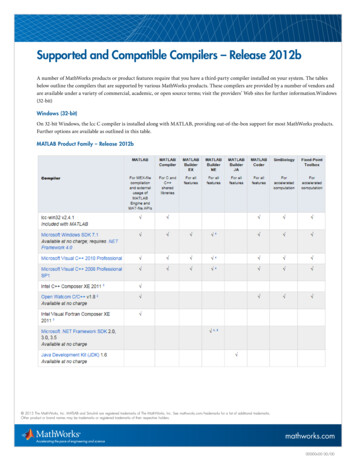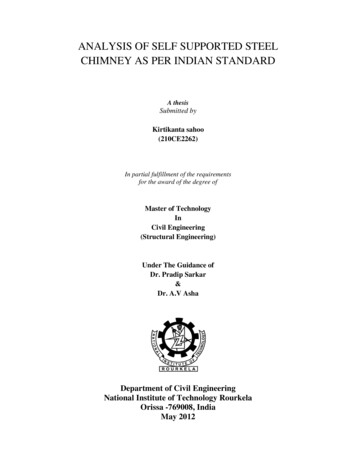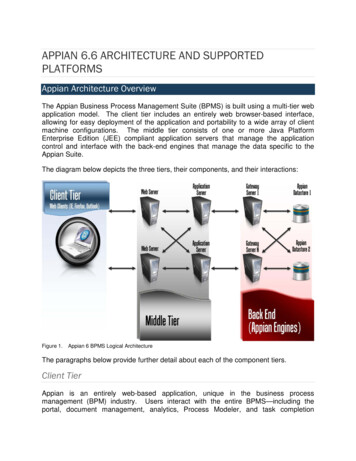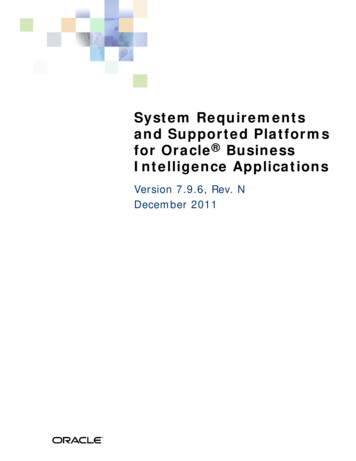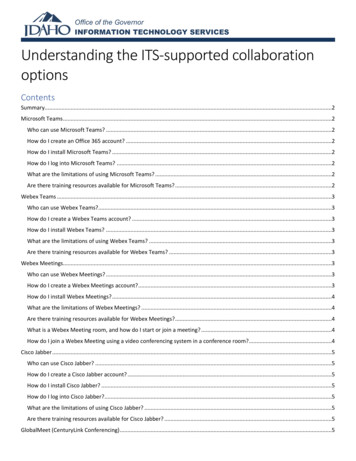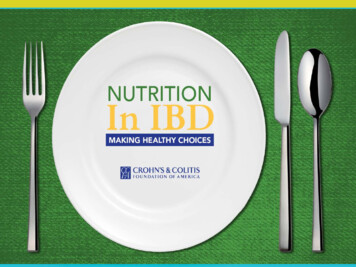
Transcription
This program is supported by a grant fromGenentech and a sponsorship fromEntera Health, andSigma Tau Pharmaceuticals, Inc.
Today’s Objectives Describe importance of diet and nutrition ininflammatory bowel diseases (IBD) Review data on the role of diet in IBD Review general healthy eating principles, andsuggestions for diet during a flare Discuss eating outside your home at holidaysand gatherings
How can IBD affect digestion?Crohn’s Disease Inflamed smallintestine; less ableto fully digest/absorb nutrients Incompletelydigested foodstravel through colon(may causediarrhea)Ulcerative colitis Small intestineworks normally Inflamed coloncauses urgency;does not reabsorbwater (diarrhea)
Good Nutrition in Your Diet is EssentialProper diet may Good nutrition is key to: More effective medications Healing, immunity, andenergy levels Improve symptoms Enable healing Sense of control Preventing/ minimizinggastrointestinal symptoms Normalizing bowel function IBD is not related to food allergy but symptoms may be worsened byfood intolerance Diet should be individualized
Host- Microbial Mutualism in the GutHost benefits to bacteria Provides a unique niche Intestinal mucus provides a source of nutritionBacteria benefits the host Fermentation of indigestible carbohydrates andthe production of SCFAs Biotransformation Urease activity participates in nitrogen balance Synthesis of certain vitamins Metabolize drugs Education of the mucosal immune systemWu, Gary. Presentation: Diet, the Gut Microbiome, and the Metabolome in IBD:Potential Therapeutic Targets and Vision for the Future.
balance of Gut Microbiota in IBD (DysbiosPeterson et al. Cell Host & Microbe. 2008;3:417-427.
Is There a Relationship Between Diet, the GutMicrobiota, and IBD?IBDAnimal s?GWAS studiesDietEEN, RD, orNPO?MicrobiotaRecent evidence in both animal modelsand healthy human subjectsSource: Adapted from Albenberg et al. Current Opinion Gastro. 2012.
Clinical Relevance of Diet and IBDPatients with IBD frequently identify dietary components that cause increasedsymptoms (lactose, gluten, etc.) and up to 75% follow restricted diets based onsubjective intolerance and perceived worsening of diseaseAdapted from Limdi et al. Inflamm Bowel Dis. 2015Foods reported to worsen IBD symptomsSpicy food164Fatty food116Alcohol84Raw vegetables/fruits77Milk/Milk products64Carbonated beverages46Coffee/Tea43Sugary food41050100150Number of respondents 238200
CCFA Partners Study Diet: no consistent patterns Patients reported fruits andnon-leafy vegetables were mostlikely to make symptoms better Fruits and non-leafy vegetablesmost likely to worsen theirsymptoms Reported symptoms may befrom food intolerances ratherthan inflammation from IBD
Diet is Associated with New OnsetIBD High dietary intakes of total fats, PUFAs, omega6 and meat were associated with an increasedrisk of CD and UC High fiber and fruit intakes were associated withdecreased CD risk High vegetable intake was associated withdecreased UC risk.Hou JK et al. American Journal of Gastro 2011;106:563-73.
Dietary Factors and UC Study of 191 patientswith UC in remission Followed over 1 year 52% of patientsrelapsed during thistime period Consumption of meat,particularly red andprocessed meatincreased the likelihoodof relapseJowett et al. Gut. 2004.
What Do Research Studies say aboutDiet, Nutrition and IBD? Limited studies Most are small, with anecdotaloutcomes Diet may have impact(example enteral nutritionaltherapy), but research needsto show how– Effects on immune system?– Changes in gut bacteria?
Diet in Animal Models of IBDAltered bile acidcomposition in liver andgall bladderMilkFatReducedsulphitesGrowth of sulphite reducing bacteria“Messenger”cells that processsignal to immunesystemIBD mice modelExacerbated colitisTH1cellImmuneresponseAdapted: Devkota et al. Nature 2012;487:104
Diet studies in humans with IBDEliminateFoodsAdd antiinflammatorysubstancesor prebioticsEnteralnutritionaltherapy
Enteral Nutritional Therapy ForCrohn’s Disease (CD) A therapy which has been used for almost 4decades Involves the use of a specific enteral formula asnutritional therapy Formula most often administered through an NGtube Exclusive (100% of calories) for a defined periodof time versus Partial (80-90% of calories) with the remainderof calories from normal foodWhitten et al. Journal of Digestive Diseases. 2012.
EN Therapy: Traditional ProtocolInduction Exclusive enteral nutrition with an elemental, semielemental, or polymeric formula Duration 4-12 weeks Oral or NG tubeMaintenance Repeated 4 week cycles of exclusive enteralnutrition every 3-4 months OR Transition to medical therapy with animmunomodulator (6-mp, azathioprine,methotrexate)
Polymeric Diet Alone vs. Steroids for ActivePediatric CD(Induction Therapy) Methods (n 37)– Prospective 10 week randomized controlled open-label trial– Newly diagnosed children receive: polymeric formula (n 18) or steroids (n 19)– Primary outcomes at 10 weeks Clinical remission (PCDAI 10) Mucosal healing– Decrease in both endoscopic and histologic scores by 50% when compared to baselineBorrelli O, et al. Clin. Gastroenterol. Hepatol.; 2006
Polymeric Diet Alone vs. Steroids forActive Pediatric CD (Induction Therapy)Enteral nutritionCorticosteroidsP 0.05%%Borrelli O, et al. Clin. Gastroenterol. Hepatol.; 2006
Medical Foods “A food which is formulated to be consumed oradministered enterally under the supervision of aphysician and which is intended for the specificdietary management of a disease or conditionfor which distinctive nutritional requirements,based on recognized scientific principles, areestablished by medical evaluation.” Examples Enteral formulas (EnteraGam, ) Multiple products available that can be tailoredto the individual needs of the patient (number ofcalories, type of protein, type and amount of fat) Can be administered as a supplement or as themajority or entirety of a patient’s calories(replace whole food) for enteral nutritionaltherapy for CD
Is There a Special Diet for IBD? NO, THERE ARE NO SPECIAL DIETS FORIBD (Exception: Enteral Nutritional Therapyfor Crohn’s disease)– However, dietary modifications may helpwith symptoms Several diets advertised specifically formanaging IBD Most have not been proven scientifically andbenefits have not been seen in formalstudies Talk to your doctor about your questions
Can a Semi-vegetarian Diet PreventRelapse of Crohn’s Disease? Adult patients withCrohn’s disease In medically orsurgically inducedremission Only treated with 5ASA after remissionachieved All were prescribedsemi-vegetarian dietChiba M, et al. World J Gastroenterol 2010
Can a semi-vegetarian diet preventrelapse of Crohn’s disease?Chiba M, et al. World Journal of Gastroenterology 2010;16 (20):2484-95
Partial EN anti-inflammatory diet Sigall-Boneh andcolleagues recentlyfound that acombination of partialenteral nutritionaltherapy and a restricteddiet could induceremission and mucosalhealing in 70% ofpatientsGlutenDairy productsGluten-free baked goodsAnimal fatProcessed meatsProducts containingemulsifiersCanned goodsAll packaged foodsSigall-Boneh et al. Inflamm Bowel Dis. 2014.
Dietary Fiber: Helpful or Harmful? Efficacy of dietary fiber was first investigated over 30 yearsago– Beneficial effects on GI tract function– Production of the fiber metabolites short chain fatty acids(butyrate in particular) Still today, most IBD patients are advised to reduce fiberconsumption Systematic review of RCT’s by Wedlake and colleagues in2014 showed no effect of supplementation of dietary fiber in12 studies on CD, possible weak effect in UC in 3/10 studies Importantly, no evidence that fiber intake should be restricted!Wedlake et al. Inflamm Bowel Dis 2014.
Curcumin and UC 50 adult patients with active mildto-moderate Active disease on mesalamineand no response to mesalaminedose adjustment (oral topical)randomized to receive curcumincapsules (3g/day) or placebo Primary outcome: rates of clinicalremission and response byclinical disease activity index(SCCAI) at week 4Lang et al. Clin Gastro and Hep. 2015.
ProbioticsWhat and HowLive microorganisms that may improve the balance of goodversus bad bacteria, Examples: Studies forapplication in IBDConclusionsE. Coli Nissle 1917Lactobacillus Bifidobacterium longumVSL#3Lactobacillus GG (LGG) inCrohn’s262002: 45 patients, no benefit2005: 75 patients, no benefit2006: 98 patients, no benefitExamples in ulcerative colitis262004: E. Coli Nissle 1917, 327 patients, benefit2006: Lactobacillus GG, 187 patients, no benefit2009: Bifidobacterium longum, 120 patients,benefit2009 Study; VSL#3 inUC27 147 patients;Improvement in clinicalactivity2010 Study; VSL#3 in UC28 144 patients; Improvement in clinicalactivity Promise for induction and maintenance of remission ofUlcerative colitis (less consistency for Crohn’s disease)More large randomized trials needed
Research on Vitamin D Higher levels of Vitamin D are associated with areduced risk of development of Crohn’s disease Vitamin D deficiency is common in IBD and isindependently associated with lower quality of lifeand greater disease activity in Crohn’s disease In a small randomized trial, oral vitamin Dreplacement reduced the risk of relapse in Crohn’sfrom 29% to 13% (p 0.06)Ananthakrishnan JK, et al. Gastroenterology. 2012;106(4):563-573.Ulitsky A, et al. J Parenter Enteral Nutr. 2011;35(3):308-316.Jørgensen SP, et al. Aliment Pharmacol Ther. 2010;32(3):377-383.
What do I tell my patients? Enteral nutritional therapy is an effective therapy forcertain patients with IBD Other general messages (but not enough data to knowfor sure!)– Red meat in moderation– The typical “Western” diet is probably not good. Emulsifiers, preservatives, long shelf life– Fiber may be beneficial (fruits, vegetables, wholegrains)– Less restrictive exclusion diets may be futuretherapies– Maintenance of adequate vitamin D levels
Considering diet in Children with IBD Up to 25% of patients with IBD are diagnosed in the pediatric agegroup Children experience more nutritional complications of their diseaseincluding: Growth failure Delayed puberty Osteoporosis Anemia Vitamin and mineral deficiencies Recommend: Initial assessment by an RD who has experience with IBDpatients and follow-up as needed Close monitoring of height velocity, body mass index (BMI), andTanner Stage (physical pubertal development) with referral toendocrinology if needed Vitamin D monitoring and baseline bone density scan (DEXA)
Risk for MalnutritionAppetite LossHigher nutrientneedsMedicationsCimperman, Lisa. Presentation: Nutrition and Inflammatory Bowel Disease: 2013.Malabsorption and poordigestionSymptoms
Common Nutrient Deficiencies:Ulcerative ColitisNutrientRisk for deficiencyFolateSulfasalazine useMagnesiumChronic DiarrheaIronGI BleedingPotassiumChronic diarrhea, vomiting and prednidone useCimperman, Lisa. Presentation: Nutrition and Inflammatory Bowel Disease: 2013.
Common Nutrient Deficiencies: Crohn’sNutrientRisk for deficiencyVitamin B12Inflammation or removal of the ileumFolateSulfasalazine use; inflammation or removal of the jejunum and/orileumVitamin AFat malabsorption; disease of the duodenum and/or upper jejunumMagnesiumInflammation or removal of large portions of the jejunum and ileum,fistula losses, chronic diarrheaZincInflammation or removal of jejunum, diarrhea, fistula losses,prednisone useCalciumAvoidance of dairy foods, fat malabsorption, prednisone use,inflammation throughout the small intestinePotassiumChronic diarrhea, vomiting and prednisone useCimperman, Lisa. Presentation: Nutrition and Inflammatory Bowel Disease: 2013.
Food Sources that May PreventDeficienciesNutrientFood SourcesVitamin B12Meat, fish, eggs, dairy products and fortified breakfastcerealsFolateFortified cereals, breads and grains, dark leafy greens,avocadosVitamin AYellow or orange fruits/vegetables, fortified milk, cheese,eggs, liverMagnesiumDark leafy greens, bananas, avocados, peas and beans,soy products, grainsZincFortified breakfast cereals, chicken, pork, yogurtCalciumSoy or dairy productsPotassiumMost fruits and vegetables – especially oranges, bananas,tomatoesCimperman, Lisa. Presentation: Nutrition and Inflammatory Bowel Disease: 2013.
Dietary Supplements Discuss all supplements with your doctor and/or dietitian Consider taking:– Daily multivitamin/mineral supplement– Calcium and vitamin D supplement 500 mg elemental calcium 3x a day 800 IU vitamin D daily You may also need:– Monthly B12 injections (if disease of the ileum)– And folate (with sulfasalazine use)
Practical Recommendations for aHealthy Diet Calories– Eat to maintain weight or– increase calories by 250-500 calories per day forweight gain Protein– Divide weight (in pounds) in half. Aim for thatamount of protein (grams/day) Fluids and Electrolytes– Divide weight (in pounds) in half. Aim for thisamount of fluid (ounces/day)– Increased needs with diarrhea or after exercise– Fluids with electrolytes (sodium, potassium) maybe required as well
Whole Grains Grains are source of carbohydrates, yourbody’s preferred energy source Also a source of fiber, several B vitamins(thiamin, riboflavin, niacin, and folate), andminerals (iron, magnesium, and selenium) Most adults need 6-8 ounces of grains per day– 1 ounce 1 slice of bread, 1 cup of readyto-eat cereal, or ½ cup of cooked rice,cooked pasta, or cooked cereal Look for whole grains as the first ingredientlisted with at least 3 grams of fiber/serving
Fruits and Vegetables A diet rich in fruits and vegetables is associated withreduced risk for heart disease, diabetes, and obesity Sources of many nutrients such as fiber, potassium andmagnesium, folate, and vitamins A and C Aim for 5-9 servings of fruits and vegetables per day 1 serving ½ cup cooked vegetables or 1 cup raw Cooked and peeled may be better tolerated“Take Charge,” Crohn’s & Colitis Foundation of America, Winter 2006“Take Charge,” Crohn’s & Colitis Foundation of America. The Fruit Connection: How Sweet it is! Spring 2006
Sources of Calcium Calcium is important for bone health, reducing the risk of osteoporosis,and involved in muscle contraction Foods that contain calcium are also sources of vitamin D,phosphorus, potassium, protein Choose 3 servings per day– 1 serving 1 cup of milk or yogurt Foods to include– Skim or 1% milk (lactose free if intolerant)– Other low-lactose options include most hardcheeses, yogurt, kefir, cottage cheese,ricotta cheese– Alternate milk options: soymilk, almond milk, rice milk“Take Charge,” Crohn’s & Colitis Foundation of America. Eating Right: Strategic Nutrition for Healthy Bones. Spring 2007
Protein Protein is important nutrient forhealing after surgery and buildingcomponents of immune system One egg, an ounce of meat, 1 cup ofmilk about 7 grams of protein Foods to include: lean meat, low fatdairy, eggs, beans, cheese, nuts/nutbutters, vegetarian meat alternatives Try to include a source of protein ateach meal
Unsaturated Fats Omega 3 Fatty Acids SalmonTunaWalnutsFlaxseed oilFortified foods Omega 3 fatty acid supplement EPA, DHA (1-3 grams) Monounsaturated Fats Olive oilCanola oilNut buttersAvocados“Take Charge,” Crohn’s & Colitis Foundation of America. Eating Right: The Skinny on Fats, Summer 2006
Potential Problem Foods Foods with added soluble fiber Artificial sweeteners and sugar alcohols Dairy products High-fat, greasy foods Spicy foods Cruciferous vegetables like broccoli, cauliflower,cabbageCimperman, Lisa. Presentation: Nutrition and Inflammatory Bowel Disease: 2013.
Potential Foods to Include During orAfter a Flare Diluted juicesApplesauceCanned fruit without added sugarOatmeal, cream of wheatPlain chicken, turkey, or fishCooked eggs or egg substituteMashed potatoes, rice, or noodlesWhite breadCimperman, Lisa. Presentation: Nutrition and Inflammatory Bowel Disease: 2013.
Examples of Popular DietsSpecific Carbohydrate DietTM Exclude starchy vegetables and grainConcerns: restrictive, can eliminate dietary sourcesof short-chain fatty acids (SCFA)- preferred source ofcolon cellsLow FODMAP DietF Fermentable (Gas producing)O Oligosaccharides (fuctans andgalacto-oligosaccharides)D Disaccharides (lactose)M Monosaccharide; (fructose)A andP Polyols (sorbitol and mannitol)AtkinsTM Emphasizes meat, eggs, cheese Limits grains, fruits, vegetables, dairyproductsConcerns: requires careful label reading; talk to adietician for complete nutritional needsConcerns: electrolyte abnormalities, dehydration,constipation; diets high in red meat associated withincreased risk of colon and prostate cancer; low fiberassociated with heart disease, stroke, diverticulitis,cancer“Take Charge,” Crohn’s & Colitis Foundation of America. The Specific Carbohydrate Diet: Does it Work? Summer 2005.
Examples of Popular DietsPaleo Eliminates refined sugar, dairy, legumes,and grains Allows meat, fish, poultry, fruits, andvegetablesConcerns: limits nutrient-dense foods like carrots,watermelonSouth Beach Diet Concerns: limits nutrient-dense foods like carrots,watermelon, bananas, and pineapple; menus average 1200 calories per day Limits disease-causing saturated fatsWeight Watchers Sound approach for weight loss Focus on increasing nutrient-dense/lowcalorie foods Portion controlConcerns: Specific needs and intolerances of IBDpatients not identified
Note on Popular Diets No specific diet has been proven to controlsymptoms of IBD Many options exist and are promoted on theinternet but – Few well-controlled published studies– Can be difficult and complicated to follow– Potentially risky – restrictions may lead to poorgrowth, poor healing, and/or nutrient deficienciesCimperman, Lisa. Presentation: Nutrition and Inflammatory Bowel Disease: 2013.
Restaurant Meals Check menus online and readdescriptions carefully Watch for hidden fat– Sauces, crispy dishes Ask for clarification ofingredients and don’t beafraid to make specialrequests! Try steamed or broiledseafood, or grilled chicken Know your trigger foods Ask for sauces and saladdressing on the side Select restaurants and menuoptions you’ve enjoyed Divide the food on yourplate in half and eat slowly Keep snacks handy
Restaurant Meals Limit caffeinated beverages and alcohol– Can irritate the GI tract and move foodthrough more quickly Alcohol interacts with many medications– Discuss potential interactions with yourphysician and pharmacist Choose water, sparkling water,unsweetened green tea, diluted juice“Take Charge,” Crohn’s & Colitis Foundation of America. Drink to Your Health? Fall 2005.
Holidays and Celebrations Know your limits! Stick to your normal eating habits as muchas possible Keep portions small; eat smaller, morefrequent meals Keep track of new foods and symptoms Inform family and friends Bring a dish you know you can eat“Take Charge,” Crohn’s & Colitis Foundation of America, 2006 Issue
Importance of a GI/Dietitian Team Work together to identifyfactors for nutrient lossand recommendedreplacement Optimized nutrition canimprove healing,particularly after surgery Make healthy nutritionalchanges to complementmedical therapies
IBD Management: Overall Picture IBD treated through a variety oftreatment approaches Good nutrition does not replaceconventional medical and surgicaltherapies for IBD Complementary approaches canhelp with symptom relief, but talk toyour doctor before taking anyalternative therapies
References Ananthakrishnan JK, et al. Gastroenterology. 2012;106(4):563-573. Cimperman, Lisa. Presentation: Nutrition and Inflammatory Bowel Disease:2013. Cohen AB, et al. Dig Dis Sci.
Crohn’s Disease Ulcerative colitis. Good Nutrition in Your Diet is Essential. . Enteral formulas ( EnteraGam, _) Multiple products available that can be tailored to the individual needs of the patient (num



